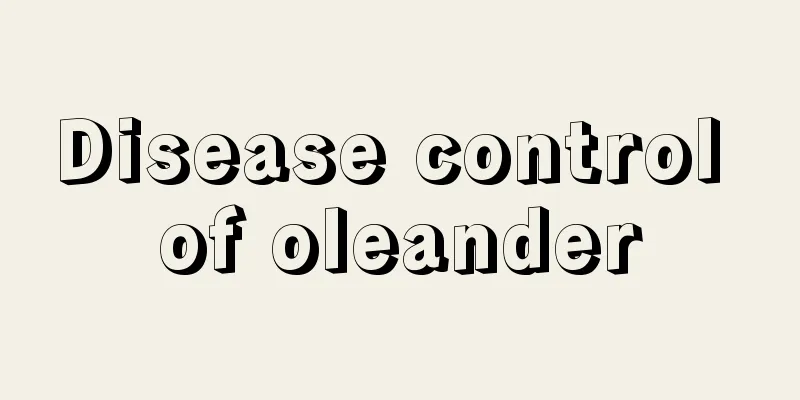Disease control of oleander

Oleander Brown SpotsymptomThis disease is more common in southern regions and can cause oleander leaves to wilt and fall prematurely. The pathogens of this disease mostly invade the oleander from the leaf tips and leaf edges. Purple-red spots will appear on leaves with brown spot disease, and then gradually expand into circular, semicircular or irregular patches with raised ring patterns on them. The lesions are brown and wide. Prevention and treatment methodsIn areas where the disease is more serious, the plants can be sprayed with 600 times diluted 40% polysulfide suspension, or 500-800 times diluted 30% cupric oxychloride, or 800-1000 times diluted 50% carbendazim wettable powder, or 1000 times diluted 70% thiophanate-methyl wettable powder, or 800-1000 times diluted carbendazim in the early stage of the disease. Spray once every 10 days or so, for a total of 2-3 times. Oleander witches' broomsymptomThe main diseases of oleander. When axillary buds and adventitious buds germinate in large numbers, many thin branches will grow, causing the internodes to shorten and the leaves to become smaller. The infected twigs will grow new twigs. The bases of the new twigs are swollen and light red, and they often grow in clusters. The twigs die in winter, and more twigs will grow next to them the following year. This cycle repeats until the entire plant dies. Prevention and treatment methodsWhen individual branches begin to show symptoms of the disease, they should be promptly cut off and destroyed. When aphids and leafhoppers are found to be causing damage, they should be killed promptly. After the disease occurs, antibiotics such as tetracycline can be used for prevention and control. Two holes can be drilled into the wood on the upper and lower sides of the diseased branch at the base of the trunk, and 1000~2000 units of tetracycline or oxytetracycline solution can be slowly injected with a syringe. The injection amount depends on the size of the plant and the severity of the disease. Generally, 30~50 ml is used per plant. Oleander Black SpotsymptomThe spots occur on the edges or middle of the leaves and are semicircular or circular. When several spots are connected, they form a wavy shape, appearing on both sides. The front side is darker than the back side, and the spots are grayish white or grayish brown. Later, a black powdery mold layer forms on the spots, which usually occurs on overwintering leaves. Prevention and treatment methodsThis disease is prone to occur in high temperature and high humidity, and harms the leaves. After the disease occurs, you can spray 500 times diluted 50% carbendazim or 600 times diluted thiophanate-methyl. For other prevention and control methods, please refer to camellia disease and pest control. |
<<: Diseases and prevention methods of peony
>>: Platycodon grandiflorum pests and diseases and their control methods
Recommend
Cuttings of Schlumbergera in summer
1. Cuttings If cuttings are carried out in the su...
Differences between Albizia Julibrissin and Jacaranda
1. Different varieties The Albizia Julibrissin be...
How long does it take for honeysuckle cuttings to take root and germinate? What is the cutting time and method with high survival rate?
Rooting time of honeysuckle cuttings Honeysuckle ...
How to grow peony trees and precautions
Growth habits of peony trees Peony trees prefer a...
How to prune and shape banyan bonsai (these methods and precautions should be mastered)
How to prune and shape a small banyan bonsai Bany...
Can the tiger skin plant survive after division? What is the method of division?
1. Can the plant survive after division? Tiger Sk...
How to plant freesia bulbs
1. Planting time It is recommended to plant frees...
No matter how long-lived and hardy the green radish is, if you keep it here, it will fail in less than 3 days!
If you grow green ivy here, it will die! The leav...
How to grow bougainvillea to make it bloom more flowers (tips for growing bougainvillea potted plants)
How to grow bougainvillea potted plants and make ...
How to change hyacinth hydroponics to soil cultivation
1. Situations where soil culture can be switched ...
Wheat planting time and method
Wheat is a common food crop and is planted in a v...
Does Campanula prefer shade or sun?
Does Campanula prefer shade or sun? Campanula is ...
How to graft passion fruit
1. Grafting method 1. Rootstock: Select disease-r...
How to repot yew
Time to repot yew Yew is a tree with a large plan...
How to grow lilies? Can you grow lilies at home?
1. How to plant 1. Time selection: Before plantin...









